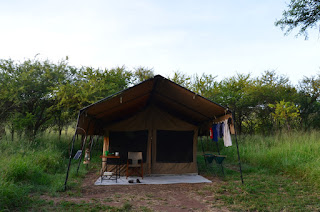 |
| Cheetah just chilling in the sun. |
The landscape is similar to the plains of southern Serengeti though the presence of Lake Ndutu and adjacent woodland provides a unique habitat. This time of the year the wildebeests and other ungulates have made their way down to the emerging grasses and apparently they will give birth to their offspring in February. This means there is also an increase of predators and carnage and as the area is famous for, an extremely dense population of wildlife.
We spent a few days viewing some of the most amazing wildlife I have ever imagined. We followed a family of lions from the woodland to the shores of the lake, watching them jump over small pools and young cubs playing with each other. We saw a dead zebra getting foraged by hyenas and vultures. We had the extreme luck of seeing two honey badgers foraging. Our early morning game drive allowed for us to see a trail of wildebeests crossing the lake, certainly a NatGeo type moment. But the crown jewel of the safari was watching a solitary male lion take down zebra. We saw the lion eye the zebra and crouch in the familiar feline hunting position. The minutes passed and everyone was on the edge of their seat when suddenly he charged and took down the zebra, clasping his jaws around the neck of the zebra. You could hear bones crunching, zebra gasps, and low grunts of the lion. Unbelievable!!!
After such a long safari (7 days) it was incredible for most of the highlights to come towards the end. We are happy that we have the interest of birds or else I would say that after the luck we had, it wouldn't be necessary to go on another safari again!
 |
| A lion couple. |
 |
| Family of lions lounging. |
 |
| Chameleon outside my room. |
 |
| Wildebeests crossing a lake in the morning light. |
 |
| Not my photo but total carnage. |
 |
| Here is the aftermath of the lion hunt. |
 |
| Family of lions. |
 |
| Solitary male lion. |
 |
| A cheetah taking a snack of a young impala. |









































